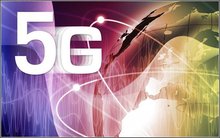The Advantage of 5g Network is Different From Other Networks
Compared the early 2G, 3G, and 4G mobile networks, the 5G network is a digital cellular network in which the service area covered by the provider is divided into a number of small geographic areas called cells.
The analog signals representing the sound and image are digitized in the handset, converted by the analog to digital converter and transmitted as a bit stream. All 5G wireless devices in the cell communicate with local antenna arrays and low power automatic transceivers (transmitters and receivers) in the cell via radio waves. The transceiver allocates channels from a common frequency pool that can be reused in geographically separated cells. The local antenna is connected to the telephone network and the Internet via a high bandwidth fiber or wireless backhaul connection. As with existing handsets, when a user traverses from one cell to another, their mobile device will automatically "switch" to the antenna in the new cell.
The main advantage of the 5G network is that the data transmission rate is much higher than that of the previous cellular network, up to 10Gbit/s, which is faster than the current wired Internet and 100 times faster than the previous 4G LTE cellular network. Another advantage is lower network latency (faster response time), less than 1 millisecond, and 4G is 30-70 milliseconds. Due to faster data transmission, 5G networks will not only serve mobile phones, but will also become a general home and office network provider, competing with cable network providers. Previous cellular networks provided low data rate Internet access for mobile phones, but a cell phone tower could not economically provide enough bandwidth as a general Internet provider for home computers.

5G Network characteristics:
1. The peak rate needs to reach the Gbit/s standard to meet the large data volume transmission of high-definition video, virtual reality and so on.
2. The air interface delay level needs to be around 1ms, which meets real-time applications such as autonomous driving and telemedicine.
3. Large network capacity, providing the connection capacity of 100 billion devices to meet IoT communication.
4. Spectrum efficiency is 10 times higher than LTE.
5. Under continuous wide area coverage and high mobility, the user experience rate reaches 100 Mbit/s.
6. The flow density and the connection number density are greatly improved.
7. System synergy, intelligent level improvement, manifested as multi-user, multi-point, multi-antenna, multi-intake collaborative networking, and flexible automatic adjustment between networks.

 Networking
Networking EMBEDDED SYSTEMS
EMBEDDED SYSTEMS Switches
Switches Wireless Solutions
Wireless Solutions Industrial Computer
Industrial Computer Cloud Services
Cloud Services



